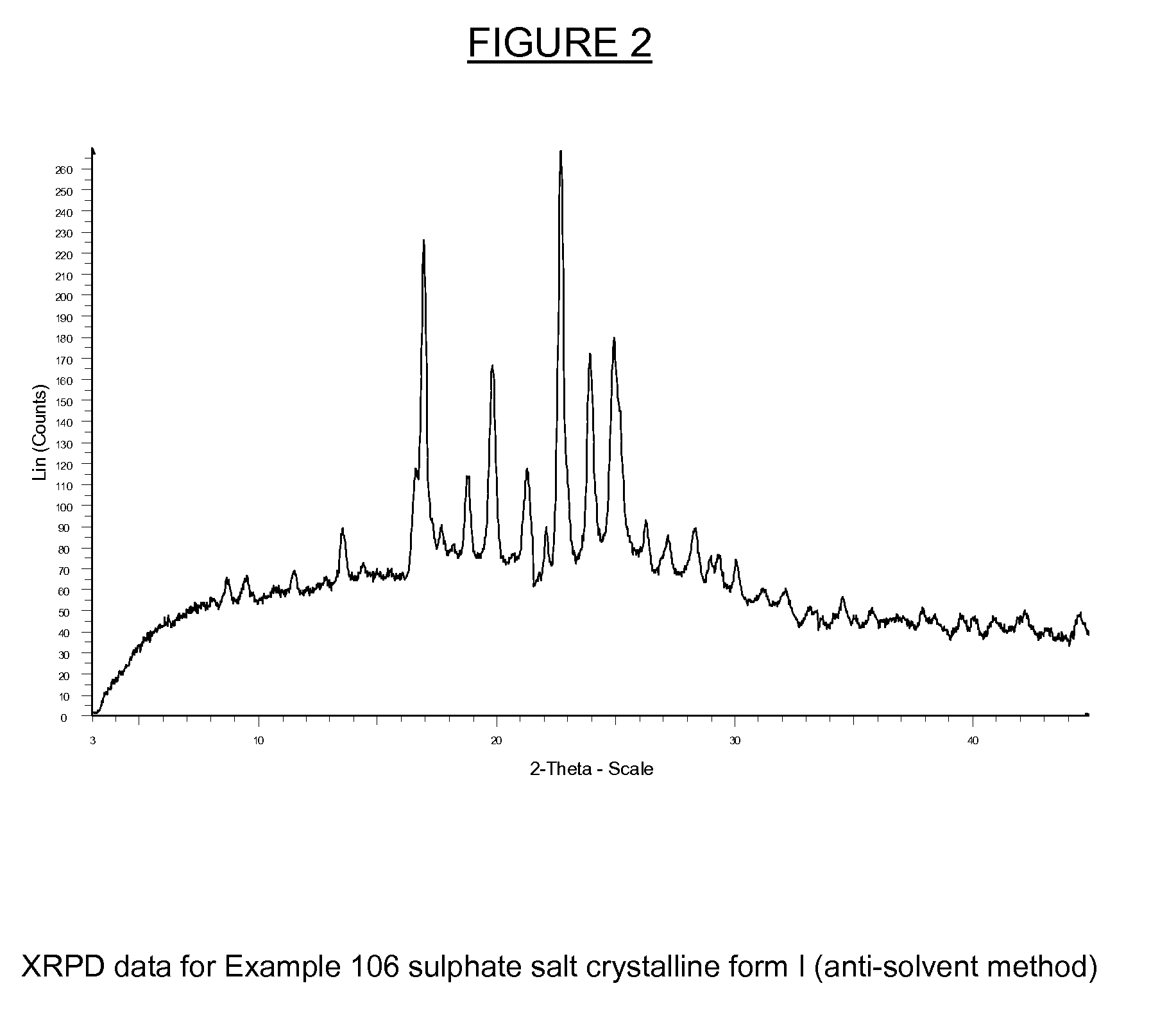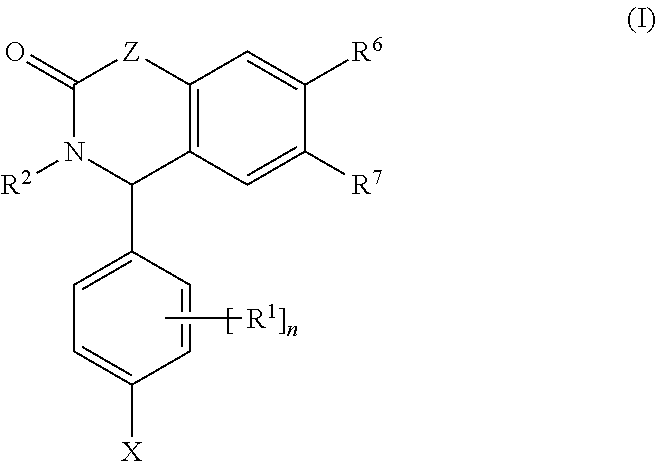Substituted isoquinolinones and quinazolinones
a technology of substituted isoquinolinones and quinazolinones, which is applied in the direction of biocide, tetracycline active ingredients, drug compositions, etc., can solve the problems of tumors, leukemias or other proliferative diseases, and uncontrolled proliferation
- Summary
- Abstract
- Description
- Claims
- Application Information
AI Technical Summary
Benefits of technology
Problems solved by technology
Method used
Image
Examples
example 1
7-((R)-sec-Butoxy)-1-(4-chloro-phenyl)-2-(4-dimethylamino-phenyl)-6-methoxy-1,4-dihydro-2H-isoquinolin-3-one
[1582]
[1583]Intermediate 1.3 (41.4 mg, 0.16 mmol) was added to a solution of Intermediate 1.4 (40 mg, 0.16 mmol) in DCM (1 ml) at RT and the resulting yellow slurry was stirred for 1 h. Methanesulfonic acid (0.10 ml, 1.6 mmol) was added drop wise and the mixture was further stirred for 15 min at RT. The reaction mixture was concentrated under vacuum and the resulting residue was purified by reverse phase prep-HPLC (Waters system) to yield the title compound (TFA salt, 10 mg, 0.017 mmol, 10%). HPLC: AtRet=2.03 min; API-MS: m / z 480.6 [M+H]+; 1H NMR (400 MHz, CDCl3): 0.93-1.03 (2t, J=7.5, 3H, mixture of diastereoisomers), 1.25-1.34 (2d, J=6.1, 3H, mixture of diastereoisomers), 1.57-1.85 (m, 2H), 3.12 (s, 6H), 3.79 (d, J=19.8, 1H), 3.86-3.95 (m, 4H), 4.17-4.26 (m, 1H), 5.74 (s, 1H), 6.68-6.74 (m, 2H), 7.06-7.11 (m, 2H), 7.18-7.24 (m, 2H), 7.26-7.32 (m, 4H).
Intermediate 1.1: [4-((R...
example 2
[1592]Compounds 2aa to 2bj were obtained analogously to Example 1 from various phenyl-acetyl chlorides (prepared analogously to Intermediate 1.3) and imines (prepared from commercially available aldehydes and anilines analogously to Intermediate 1.4).
[1593]
#StructureName / HPLC / MS2aa1-(4-Chloro-phenyl)-2-(4-dimethylamino-phenyl)-6,7- diethoxy-1,4-dihydro-2H-isoquinolin-3-one. HPLC: AtRet = 1.88; API-MS: m / z 465.3 [M + H]+.2ab1-(3,4-Difluoro-phenyl)-6,7-diethoxy-2-(4-methoxy- phenyl)-1,4-dihydro-2H-isoquinolin-3-one. HPLC: AtRet = 2.51; API-MS: m / z 454.3 [M + H]+.2ac4-[1-(4-Chloro-phenyl)-6,7-diethoxy-3-oxo-3,4-dihydro- 1H-isoquinolin-2-yl]-benzonitrile. HPLC: AtRet = 2.60; API-MS: m / z 447.1 [M + H]+.2ad1-(4-Chloro-phenyl)-6,7-diethoxy-2-(5-methyl-pyridin- 2-yl)-1,4-dihydro-2H-isoquinolin-3-one. HPLC: AtRet = 2.67; API-MS: m / z 437.2 [M + H]+.2ae2-Benzofuran-5-yl-1-(4-chloro-phenyl)-6,7-diethoxy- 1,4-dihydro-2H-isoquinolin-3-one. HPLC: AtRet = 2.67; API-MS: m / z 462.1 [M + H]+.2am1-(4-Ch...
example 3
{2-[7-((R)-sec-Butoxy)-2-(4-dimethylamino-phenyl)-6-methoxy-3-oxo-1,2,3,4-tetrahydro-isoquinolin-1-yl]-5-chloro-phenyl}-urea
[1594]
[1595]A mixture of Intermediate 3.3 (20 mg, 0.040 mmol) and NaOCN (7.9 mg, 0.121 mmol) in AcOH (1 ml) and water (2 ml) was stirred at RT for 2 h. The reaction mixture was directly subjected to purification by reverse phase prep-HPLC (Waters system) to yield the title compound (TFA salt, 13.0 mg, 0.020 mmol, 49%) as a colorless solid. HPLC: AtRet=1.62 min; LC-MS: m / z 537.4 [M+H]+; 1H NMR (400 MHz, DMSO-d6): 0.78-0.92 (2t, J=7.5, 3H, mixture of diastereoisomers), 1.04-1.21 (2d, J=6.1, 3H, mixture of diastereoisomers), 1.41-1.67 (m, 2H, mixture of diastereoisomers), 2.88 (s, 6H), 3.64 (d, J=20.8, 1H), 3.73 (s, 3H), 4.02 (dd, J=20.8, 4.6, 1H), 4.08-4.18 (m, 1H), 6.15 (br. s., 2H), 6.25 (s, 1H), 6.65-6.73 (m, 2H), 6.79-6.85 (m, 2H), 6.86-6.93 (m, 2H), 7.01-7.08 (m, 1H), 7.31 (dd, J=8.6, 2.2, 1H), 7.74 (dd, J=17.6, 2.2, 1H), 7.99-8.05 (m, 1H).
Intermediate 3.1
N-...
PUM
 Login to View More
Login to View More Abstract
Description
Claims
Application Information
 Login to View More
Login to View More - R&D
- Intellectual Property
- Life Sciences
- Materials
- Tech Scout
- Unparalleled Data Quality
- Higher Quality Content
- 60% Fewer Hallucinations
Browse by: Latest US Patents, China's latest patents, Technical Efficacy Thesaurus, Application Domain, Technology Topic, Popular Technical Reports.
© 2025 PatSnap. All rights reserved.Legal|Privacy policy|Modern Slavery Act Transparency Statement|Sitemap|About US| Contact US: help@patsnap.com



